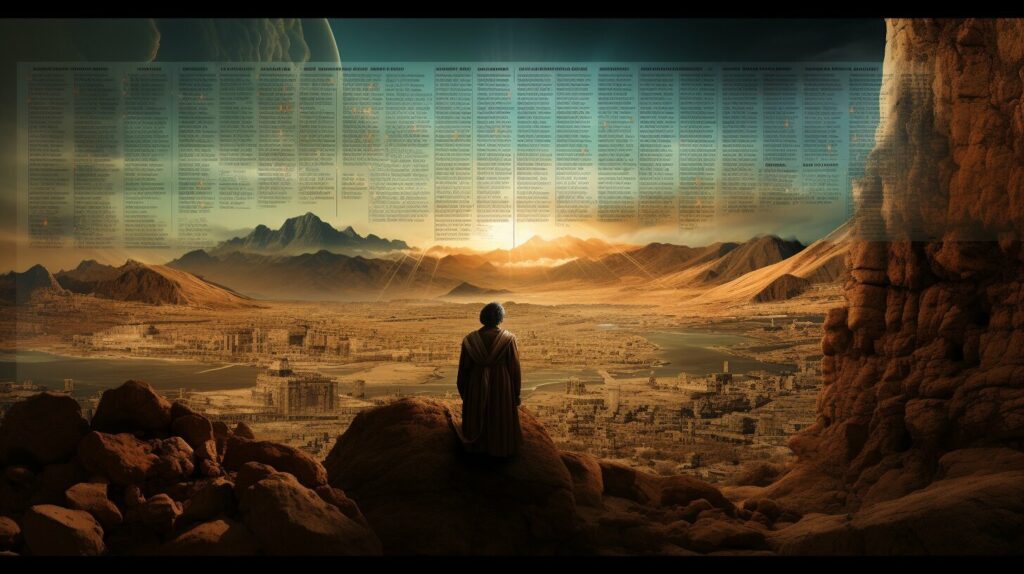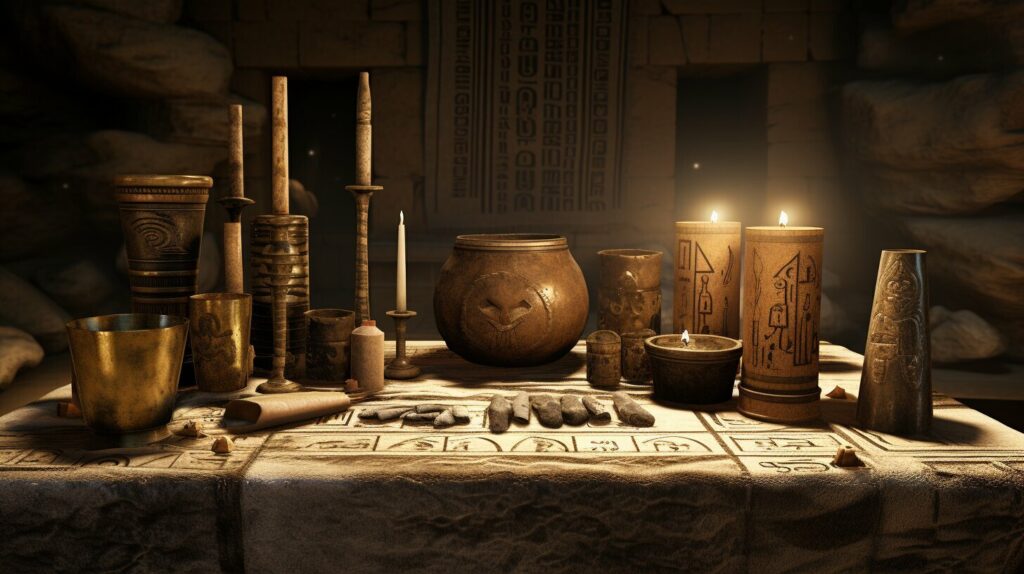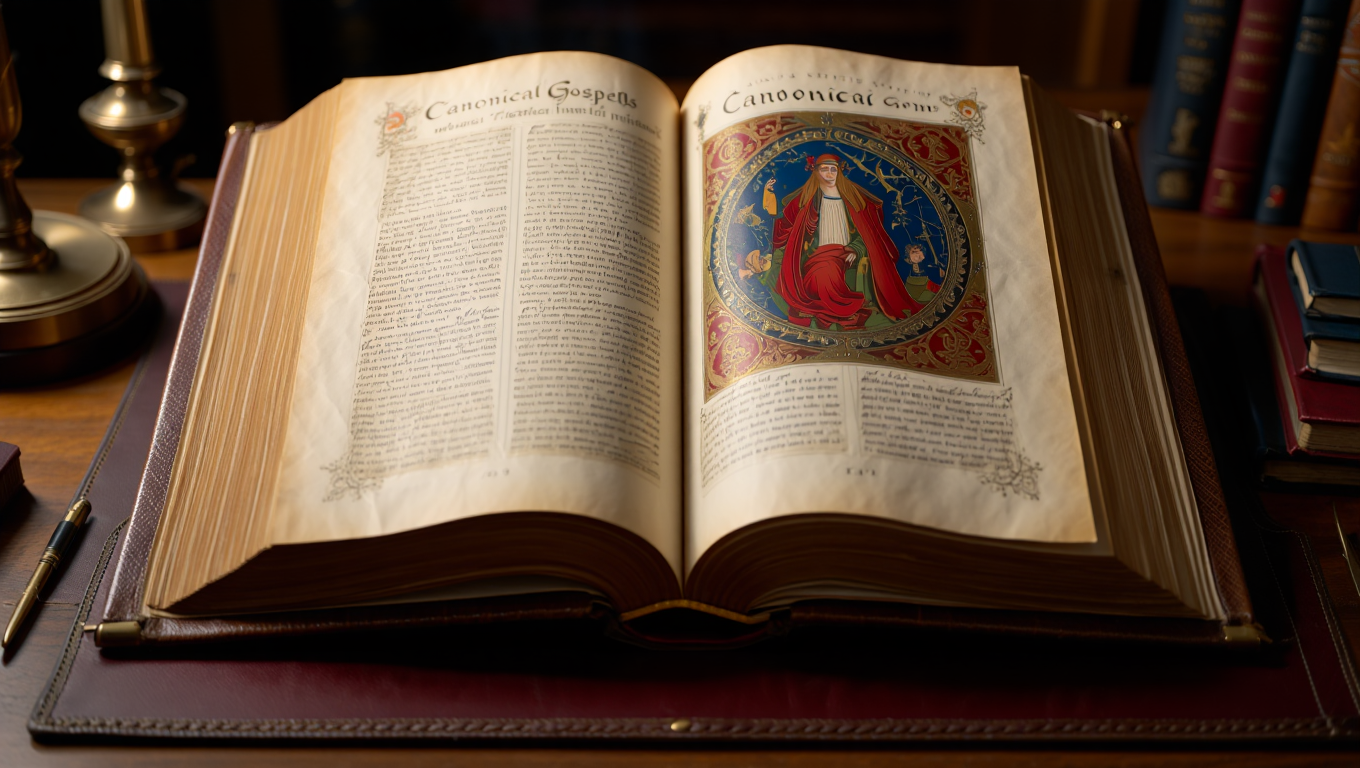The Dead Sea Scrolls and the Nag Hammadi Texts are two significant collections of ancient manuscripts that have intrigued scholars and religious enthusiasts alike. These texts provide valuable insights into early Christianity, ancient Judaism, and the broader context of antiquity.
The Dead Sea Scrolls were discovered in Qumran and consist of over 800 texts dating from around 250 BCE to 100 CE. They include biblical manuscripts as well as other writings related to Jewish sectarian groups. These manuscripts have immense historical significance and have contributed to our understanding of ancient religious texts and early Jewish beliefs.
The Nag Hammadi Texts, on the other hand, were found in Nag Hammadi and consist of 13 leather-bound books containing 55 texts. Dating from the first few centuries of the Christian era, these texts primarily represent previously unknown Christian writings. They are often described as “Gnostic” in character, offering unique perspectives on the early development of Christianity.
While the Dead Sea Scrolls focus on early Judaism, the Nag Hammadi Texts provide insights into early Christianity, making them invaluable for scholars studying the origins of the Christian faith. By studying both corpora together, biblical scholars and historians can gain a more comprehensive understanding of the religious, social, and cultural landscape of the time.
- The Dead Sea Scrolls and the Nag Hammadi Texts are significant collections of ancient manuscripts.
- The Dead Sea Scrolls include biblical manuscripts and writings related to Jewish sectarian groups, while the Nag Hammadi Texts primarily represent previously unknown Christian writings.
- Studying both corpora together provides a holistic understanding of early Judaism and early Christianity.
- The Dead Sea Scrolls contribute to our understanding of early Jewish beliefs, while the Nag Hammadi Texts shed light on alternative Christianities.
- These manuscripts have immense historical significance and continue to be subjects of scholarly research and fascination.
Historical Background and Discovery
The Dead Sea Scrolls were discovered in the vicinity of Qumran, a site near the Dead Sea, while the Nag Hammadi Texts were unearthed in the Egyptian village of Nag Hammadi. These ancient discoveries have significantly contributed to our understanding of early Christianity and ancient Judaism.
The Dead Sea Scrolls, dating from around 250 BCE to 100 CE, consist of over 800 texts. These include biblical manuscripts, religious writings, and texts associated with various Jewish sectarian groups. The significance of these artifacts lies in the fact that they provide invaluable insights into the religious and historical context of ancient Judaism.
On the other hand, the Nag Hammadi Texts date from the first few centuries of the Christian era. They are a collection of 55 texts contained within 13 leather-bound books. These texts primarily represent previously unknown Christian writings, often referred to as “Gnostic” texts. The Nag Hammadi Texts offer unique perspectives on early Christian beliefs, providing a glimpse into the diverse range of spiritual and theological ideas that existed during that time.
As both collections shed light on different aspects of ancient religious traditions, scholars have increasingly recognized the importance of studying the Dead Sea Scrolls and the Nag Hammadi Texts together. By examining these ancient artifacts side by side, researchers gain a more comprehensive understanding of the complexities and nuances of early Christianity and ancient Judaism.

Contents of the Dead Sea Scrolls
The Dead Sea Scrolls encompass over 800 texts, including biblical manuscripts and other writings associated with different Jewish sectarian groups of the time. These ancient manuscripts were discovered in the mid-20th century near the Dead Sea in Qumran, Israel. The texts, written on various materials such as parchment and papyrus, date from around 250 BCE to 100 CE. They provide valuable insights into the religious and cultural practices of ancient Judaism.
The texts found among the Dead Sea Scrolls cover a wide range of topics, including religious law, prayers, hymns, biblical commentaries, and community rules. Many of these manuscripts are thought to have been written by the Essenes, a Jewish sect living in the region during that time. They are of immense historical and religious significance, as they shed light on the development of Jewish thought and contribute to our understanding of the Bible and the early Jewish community.
A major portion of the Dead Sea Scrolls consists of biblical manuscripts, including fragments of every book of the Hebrew Bible, except for the Book of Esther. These biblical texts provide important insights into the transmission and preservation of the Hebrew Scriptures. The scrolls also include non-biblical texts, such as liturgical compositions, apocryphal works, and writings that express the beliefs and practices of the sectarian groups living near the Dead Sea.
| Types of Texts | Example |
|---|---|
| Biblical Manuscripts | Fragment of the Book of Isaiah |
| Apocryphal Works | The Book of Tobit |
| Community Rules | The Community Rule (Serekh ha-Yahad) |

The Dead Sea Scrolls provide a window into the religious beliefs and practices of ancient Judaism. They offer unique insights into the development of Jewish thought and provide valuable context for understanding the Bible. These ancient manuscripts continue to captivate scholars and researchers around the world.
Significance of the Dead Sea Scrolls
The Dead Sea Scrolls have revolutionized our understanding of ancient Judaism and the early development of the Hebrew Bible. Their discovery has sparked intense scholarly debate and has deepened our knowledge of religious practices during that time. Through the study of these remarkable texts, we gain a richer understanding of the historical and cultural context in which ancient Judaism and the Bible emerged.
- They reveal the diversity of Jewish beliefs and practices during the Second Temple period.
- They provide important textual variations of biblical books, shedding light on the process of textual transmission.
- They offer insights into the historical, social, and religious context of the time, including the political tensions and sectarian divisions.
Overall, the Dead Sea Scrolls have become invaluable sources for biblical scholars, historians, and those interested in ancient religious texts. They continue to inspire further research and exploration, offering a unique window into the rich tapestry of ancient Jewish life.
Contents of the Nag Hammadi Texts
The Nag Hammadi Texts consist of 13 leather-bound books containing 55 texts, primarily representing previously unknown Christian writings with a distinctive “Gnostic” character. These texts were discovered in 1945 in the Egyptian town of Nag Hammadi and have since been recognized as a valuable source of insight into early Christianity and its diverse beliefs.
Among the texts found in the Nag Hammadi library are the Gospel of Thomas, the Gospel of Philip, and the Gospel of Truth, each offering unique perspectives on the teachings of Jesus and the early Christian community. These texts often explore esoteric and mystical themes, presenting alternative viewpoints that challenge the traditional understanding of Christian doctrine.
The Nag Hammadi Texts also include a range of other writings, such as treatises, hymns, and apocalyptic texts. These works delve into topics like cosmology, creation myths, and the nature of the divine, providing a glimpse into the rich spiritual and intellectual landscape of the early Christian era.
Studying the Nag Hammadi Texts alongside the Dead Sea Scrolls allows scholars to gain a more comprehensive understanding of ancient beliefs, religious diversity, and the development of early Christianity. Comparing the texts from both collections sheds light on the diverse religious currents and theological debates that shaped the ancient world.

| Dead Sea Scrolls | Nag Hammadi Texts |
|---|---|
| Focuses on early Judaism | Provides insights into early Christianity |
| Includes biblical manuscripts | Consists of previously unknown Christian writings |
| Highlights religious texts and writings related to Jewish sectarian groups | Explores esoteric and mystical themes within early Christian writings |
“The Nag Hammadi Texts offer a unique window into the diverse beliefs and spirituality of early Christianity. Through these writings, we can explore alternative perspectives on Jesus’ teachings and gain a deeper understanding of the complexity of the ancient Christian world.” – Biblical Scholar
By examining the contents of the Nag Hammadi Texts, scholars have the opportunity to uncover lost perspectives and marginalized beliefs that have long been overshadowed by mainstream Christian traditions. These texts challenge our preconceived notions and provide valuable insights into the religious diversity that existed within early Christianity.
As we delve into the Nag Hammadi Texts, we discover a treasure trove of ancient wisdom and spiritual traditions that expand our understanding of the early Christian era. These texts offer a glimpse into the different paths that individuals and communities followed in their quest for spiritual enlightenment and transcendence.
Dating and Historical Context
The Dead Sea Scrolls date from around 250 BCE to 100 CE, covering a span of several centuries, while the Nag Hammadi Texts primarily originate from the first few centuries of the Christian era. These ancient manuscripts provide valuable insights into the historical context of the periods in which they were written.
The Dead Sea Scrolls, discovered in the mid-20th century near the Dead Sea in present-day Israel, offer a glimpse into the religious and cultural life of ancient Judaism. These texts were produced by a Jewish sect known as the Essenes and include biblical manuscripts, prayers, hymns, legal texts, and other writings. They provide a unique perspective on Jewish beliefs and practices during this time.
The Nag Hammadi Texts, found in the late 1940s in Egypt, shed light on early Christian thought and the diversity of beliefs within the early Christian movement. These texts were buried for centuries, likely by a community of Gnostic Christians, and were discovered by chance. The Nag Hammadi Texts consist of various writings, including gospels, apocalyptic texts, and philosophical treatises, offering a rich tapestry of early Christian literature that challenges traditional understandings of the Christian faith.
| Dead Sea Scrolls | Nag Hammadi Texts |
|---|---|
| Found near the Dead Sea in Israel | Discovered in Nag Hammadi, Egypt |
| Focuses on ancient Judaism | Provides insights into early Christianity |
| Contains biblical manuscripts and writings related to Jewish sectarian groups | Primarily consists of unknown Christian writings, often described as “Gnostic” in character |
Studying the dating and historical context of these ancient manuscripts allows us to gain a deeper understanding of the religious and cultural landscape of the ancient world. It helps us appreciate the diverse range of ideas and beliefs that existed during these periods and encourages us to question and reassess our understanding of early Christianity and ancient Judaism.

Scholarly Interpretations and Significance
Both the Dead Sea Scrolls and the Nag Hammadi Texts hold great scholarly importance, providing unique insights into the religious and historical aspects of early Christianity and ancient Judaism. These ancient texts offer a glimpse into the beliefs, practices, and diverse perspectives of the communities that produced them.
Biblical scholars have dedicated years of research to studying these manuscripts, uncovering hidden truths and shedding light on ancient traditions. The historical significance of these texts cannot be overstated, as they provide valuable context for understanding the development of early Christian and Jewish thought.
“The Dead Sea Scrolls and the Nag Hammadi Texts have revolutionized our understanding of the biblical world. They have offered new perspectives on ancient Judaism and early Christianity, challenging our preconceived notions and expanding our knowledge of these ancient faiths.” – Dr. Sarah Thompson, Biblical Scholar
The Dead Sea Scrolls, with their collection of biblical manuscripts and writings related to Jewish sectarian groups, provide invaluable insights into the complex tapestry of ancient Judaism. These texts help us understand the diversity of religious beliefs and practices during this time period.
The Nag Hammadi Texts, on the other hand, offer a unique window into early Christianity and its various expressions. These Gnostic texts, previously unknown to scholars, reveal alternative Christian perspectives and shed light on marginalized beliefs and spiritual traditions that were pushed to the fringes of orthodox Christianity.
By studying both the Dead Sea Scrolls and the Nag Hammadi Texts together, scholars can compare and contrast the beliefs, practices, and ideologies of different religious communities in the ancient world. This comparative analysis not only enriches our understanding of early Christianity and ancient Judaism but also allows us to explore the broader context of religious diversity and spiritual traditions in antiquity.
Table: Comparing the Dead Sea Scrolls and the Nag Hammadi Texts
Below is a table summarizing the main differences between the Dead Sea Scrolls and the Nag Hammadi Texts:
| Dead Sea Scrolls | Nag Hammadi Texts |
|---|---|
| Discovered in Qumran | Discovered in Nag Hammadi |
| Over 800 texts, including biblical manuscripts and writings related to Jewish sectarian groups | 13 leather-bound books containing 55 texts, primarily representing previously unknown Christian writings |
| Dating from around 250 BCE to 100 CE | Dating from the first few centuries of the Christian era |
| Focus on early Judaism | Provide insights into early Christianity and alternative Christian perspectives |

A comparative analysis of the Dead Sea Scrolls and the Nag Hammadi Texts reveals both similarities and differences in terms of their content, context, and the perspectives they provide on early religious beliefs.
The Dead Sea Scrolls, discovered in Qumran, consist of over 800 texts dating from around 250 BCE to 100 CE. These ancient manuscripts include biblical manuscripts, religious writings, and texts related to Jewish sectarian groups. They provide a unique window into the religious practices and beliefs of ancient Judaism.
In contrast, the Nag Hammadi Texts, found in Nag Hammadi, consist of 13 leather-bound books containing 55 texts. Dating from the first few centuries of the Christian era, these texts primarily represent previously unknown Christian writings, often described as “Gnostic” in character. They offer valuable insights into early Christian thought and alternative perspectives on spirituality during that time.
| Dead Sea Scrolls | Nag Hammadi Texts |
|---|---|
| Focus on ancient Judaism | Focus on early Christianity |
| Includes biblical manuscripts | Contains previously unknown Christian writings |
| Offers insights into Jewish sectarian groups | Provides alternative perspectives on spirituality |
Studying both corpora together allows scholars to gain a more comprehensive understanding of the religious and cultural landscape of the time. It enables a comparative analysis of the similarities and differences between these early religious texts, shedding light on the diversity of beliefs and practices during that era.

Importance of Studying Both Corpora
Scholars have recognized the significance of studying the Dead Sea Scrolls and the Nag Hammadi Texts together, as it allows for a holistic approach to ancient literature and provides valuable insights into the religious developments of early Christianity and ancient Judaism. These two collections of ancient texts, although originating from different regions and religious contexts, both offer unique perspectives on the religious and social landscape of the time.
By studying the Dead Sea Scrolls alongside the Nag Hammadi Texts, researchers can gain a broader understanding of the diverse beliefs and practices that existed within early Christian and Jewish communities. The Dead Sea Scrolls, with their focus on early Judaism, shed light on the religious and cultural milieu of ancient Jewish sects. These texts provide valuable insights into their beliefs, rituals, and theological interpretations.
On the other hand, the Nag Hammadi Texts present a different side of the story, illuminating the early development of Christian thought and the existence of diverse interpretations of the faith. These texts, often described as “Gnostic” in character, challenge traditional understandings of early Christianity and offer alternative perspectives on key theological concepts. Exploring both corpora side by side enables scholars to examine the nuances and complexities of ancient religious traditions, enriching our understanding of this transformative period in human history.
Table: Comparative Analysis of the Dead Sea Scrolls and the Nag Hammadi Texts
| Dead Sea Scrolls | Nag Hammadi Texts |
|---|---|
| Discovered in Qumran | Discovered in Nag Hammadi |
| Over 800 texts, including biblical manuscripts and writings related to Jewish sectarian groups | 13 leather-bound books containing 55 texts, primarily representing previously unknown Christian writings |
| Focus on early Judaism | Provide insights into early Christianity and alternative Christian beliefs |
| Written between 250 BCE and 100 CE | Dating back to the first few centuries of the Christian era |
Studying the Dead Sea Scrolls and the Nag Hammadi Texts together not only deepens our knowledge of ancient literature but also enhances our understanding of the historical and cultural context within which early Christianity and ancient Judaism emerged. By examining these corpora in tandem, researchers can uncover the shared influences and distinct characteristics of these religious traditions, offering a comprehensive view of the diverse and fascinating developments that shaped our world centuries ago.

The Dead Sea Scrolls and the Nag Hammadi Texts captivate scholars and enthusiasts alike, as they unlock ancient mysteries and reveal religious and philosophical insights that were previously unknown. These enigmatic texts provide a glimpse into the rich tapestry of ancient beliefs and esoteric traditions that existed during the early centuries of the Christian era. They offer a unique window into the spiritual and intellectual landscape of the time, shedding light on hidden knowledge and religious revelations.
Within the scrolls and texts, readers encounter a diverse range of ideas and perspectives, challenging conventional understandings of ancient religions and offering alternative ways of viewing the world. They explore the complexities of early Christian thought and the intricacies of ancient Judaism, showcasing the richness and diversity of religious and spiritual traditions that once thrived.
The study of these ancient manuscripts requires careful examination and interpretation, as each text presents its own set of linguistic, historical, and philosophical challenges. Scholars meticulously analyze these texts, delving into their symbolism, narratives, and theological perspectives, in order to piece together a comprehensive understanding of the ancient world.
| Ancient Mysteries | Enigmatic Texts | Religious Revelations | Hidden Knowledge | Esoteric Beliefs |
|---|---|---|---|---|
| The Dead Sea Scrolls | The Nag Hammadi Texts | Ancient manuscripts | Early Christian era | Ancient Judaism |
“The Dead Sea Scrolls and the Nag Hammadi Texts offer a fascinating glimpse into the religious and philosophical beliefs of our ancestors. These ancient manuscripts hold the key to unlocking the mysteries of the past and allow us to explore the depths of human spirituality.”
By studying these remarkable texts, researchers and readers alike can gain a deeper comprehension of the ancient world and the spiritual traditions that shaped it. As we unravel the secrets concealed within these ancient manuscripts, we uncover lost perspectives and uncover forgotten aspects of our collective history. The Dead Sea Scrolls and the Nag Hammadi Texts are invaluable resources that continue to inspire and enlighten, providing a bridge between the past and the present.

Uncovering Lost Perspectives
The Nag Hammadi Texts have played a crucial role in uncovering lost perspectives, allowing us to explore alternative Christianities and discover the rich tapestry of spiritual traditions that existed during the early Christian era. These texts, consisting of 13 leather-bound books containing 55 texts, provide valuable insights into the diverse range of beliefs and practices that were present at the time.
One of the key contributions of the Nag Hammadi Texts is the revelation of marginalized beliefs that were previously unknown or overlooked. These texts challenge the traditional narrative of early Christianity by showcasing different theological viewpoints and alternative interpretations of sacred texts. By studying these texts alongside mainstream Christian writings, we gain a more comprehensive understanding of the religious diversity that existed in the ancient world.
These texts also shed light on the existence of alternative Christianities that coexisted alongside the more dominant forms of the religion. They offer glimpses into the spiritual traditions of different communities and provide valuable insights into their rituals, beliefs, and practices. By exploring these alternative perspectives, we expand our understanding of the complex and multifaceted nature of early Christianity.
Table: Comparison of Mainstream and Alternative Christianities
| Mainstream Christianity | Alternative Christianities |
|---|---|
| Emphasized the divinity of Jesus Christ | Explored different interpretations of Jesus’ nature |
| Followed set liturgical practices | Engaged in unique rituals and ceremonies |
| Adhered to canonical writings | Valued non-canonical texts and secret teachings |
| Structured hierarchical organization | Embraced egalitarian community structures |
Through the study of the Nag Hammadi Texts, we begin to unravel the complexities of early Christian history and gain a deeper appreciation for the diverse range of beliefs and spiritual traditions that existed during that time. These lost perspectives not only challenge our preconceived notions but also reveal the richness and complexity of ancient religious thought.

In conclusion, the Dead Sea Scrolls and the Nag Hammadi Texts provide invaluable insights into the realms of early Christianity and ancient Judaism, allowing us to delve into the rich tapestry of ancient manuscripts and uncover the mysteries of the past.
The Dead Sea Scrolls, discovered in Qumran, consist of over 800 texts dating from around 250 BCE to 100 CE. These manuscripts include biblical texts and writings related to Jewish sectarian groups, offering a glimpse into the religious and cultural landscape of ancient Judaism.
On the other hand, the Nag Hammadi Texts, found in Nag Hammadi, offer a unique perspective on early Christianity. Consisting of 13 leather-bound books with 55 texts, these writings represent previously unknown Christian works that provide insights into alternative Christianities and spiritual traditions of the time.
By studying both the Dead Sea Scrolls and the Nag Hammadi Texts together, scholars have gained a more comprehensive understanding of the early Christian era and ancient Jewish history. This comparative analysis has shed light on the connections and distinctions between these two major religious traditions and has enhanced our knowledge of the broader historical and cultural context in which they flourished.
FAQ
What are the Dead Sea Scrolls?
The Dead Sea Scrolls are ancient manuscripts discovered in Qumran, consisting of over 800 texts dating from around 250 BCE to 100 CE. They include biblical manuscripts and writings related to Jewish sectarian groups.
What are the Nag Hammadi Texts?
The Nag Hammadi Texts are 13 leather-bound books containing 55 texts discovered in Nag Hammadi. Dating from the first few centuries of the Christian era, they primarily consist of previously unknown Christian writings, often described as “Gnostic” in character.
How do the Dead Sea Scrolls and Nag Hammadi Texts differ?
The Dead Sea Scrolls focus on early Judaism, while the Nag Hammadi Texts provide insights into early Christianity. The Dead Sea Scrolls include biblical manuscripts and writings related to Jewish sectarian groups, while the Nag Hammadi Texts primarily consist of previously unknown Christian writings.
What is the historical significance of the Dead Sea Scrolls and Nag Hammadi Texts?
Both the Dead Sea Scrolls and Nag Hammadi Texts are of great historical significance. They provide valuable insights into the religious and cultural context of ancient times and offer a glimpse into the beliefs and practices of early Judaism and Christianity.
How were the Dead Sea Scrolls and Nag Hammadi Texts discovered?
The Dead Sea Scrolls were discovered in Qumran, near the Dead Sea, between 1947 and 1956. The Nag Hammadi Texts were found in 1945 near Nag Hammadi, Egypt. Both discoveries were made by chance, and these ancient texts have since become invaluable for scholars and researchers.
What do the Dead Sea Scrolls contain?
The Dead Sea Scrolls contain a diverse range of texts, including biblical manuscripts, religious writings, and documents related to Jewish sectarian groups. They provide valuable insights into the beliefs, practices, and literature of ancient Judaism.
What do the Nag Hammadi Texts contain?
The Nag Hammadi Texts consist primarily of previously unknown Christian writings. These texts offer unique perspectives on early Christian beliefs and practices, often classified as “Gnostic” in nature.
When were the Dead Sea Scrolls and Nag Hammadi Texts written?
The Dead Sea Scrolls date from around 250 BCE to 100 CE, while the Nag Hammadi Texts were written in the first few centuries of the Christian era. Both collections provide valuable insights into the early centuries of Judaism and Christianity.
Why is it important to study both the Dead Sea Scrolls and Nag Hammadi Texts together?
Studying both the Dead Sea Scrolls and Nag Hammadi Texts allows for a more comprehensive understanding of early Christianity, ancient Judaism, and the broader literary and historical context of that era. It provides a holistic approach to exploring ancient religious texts.
What can we learn from the comparative analysis of the Dead Sea Scrolls and Nag Hammadi Texts?
A comparative analysis of these two collections helps us identify similarities and differences between early Jewish and Christian writings. It enhances our understanding of the diverse religious beliefs and practices of the time and contributes to the broader field of textual analysis.
How do the Dead Sea Scrolls and Nag Hammadi Texts contribute to our understanding of ancient mysteries?
The Dead Sea Scrolls and Nag Hammadi Texts contain enigmatic and esoteric writings that offer glimpses into ancient religious revelations and hidden knowledge. They provide valuable clues to the mysteries and beliefs of ancient societies.
What perspectives do the Nag Hammadi Texts uncover?
The Nag Hammadi Texts shed light on alternative Christianities and spiritual traditions that were previously marginalized or overlooked. They broaden our understanding of the religious diversity and different perspectives that existed in the early Christian era.
 Skip to main content
Skip to main content


